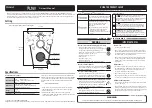
16
5.2
How to make the basic alignment?
5.2.1
Preparation of the glass beads
First, the glass beads, which are supplied with the calibration set, have to be prepared. The
preparation of the dry glass beads is uncritical: Fill up one of the containers until the rods of the
probe could completely be inserted. To achieve a constant density, knock the container several
times against the ground. After a long usage of the glass beads the density increases. Therefore
they should be poured out into another bucket and poured back to achieve the original density.
The preparation of the water saturated glass beads is more critical, because water dissolves
Na
2
O and K
2
O from glass. This causes a rising pH-value and an increased electrical
conductivity. This property is most intensive with new glass beads. Therefore the glass beads
should be washed intensively with tap water in a large container (e.g. 10 litre bucket). Fill a
bucket with water, stir the beads under water and then pour out the water. This procedure should
be done at least five times, each time with fresh water. If the glass beads have been in use for a
longer time, three times is enough.
Now the second calibration container has to be filled with water in order to be able to fill in the
glass beads without remaining air-bubbles. An additional precaution to remove air-bubbles is to
stir slightly while filling in the glass beads. The container must now be knocked against the
ground some times to achieve a constant density. The surplus water must be poured out until the
thickness of the water film above the glass beads is below 2mm.
The water saturated glass beads should be in a temperature range between 20°C and 25°.
Please note that the electrical conductivity of the water saturated glass beads medium
increases already after a few days storage.
Therefore the glass beads must be washed again
before the next calibration.
5.2.2
Basic alignment procedure
The basic alignment can be done with both the calibration connector (only TRIME-FM) and the
calibration program SMCAL (
please read the information about the basic alignment with SMCAL in the file
README.TXT in the subdirectory BASICCAL of the SMCAL-disk
).
Only the procedure with the calibration connector is described in the following:
Before starting the essential calibration, connect the probe to the TRIME-FM and press the
START
button to switch on the instrument. After this „dummy measurement“ is finished, you can
plug in the calibration connector at the side of the TRIME-FM. The display shows the first
reference value of dry glass beads for the appropriate probe (e.g. 2,8%). The probe cable must
now be unwound and spread out in a way that the cable doesn't touch itself. Moreover, it must
have a distance to metal objects (e.g. metal table-top) of at least 10cm. The probe must now be
stuck vertically into the dry glass beads. Both, container and TRIME instruments, shouldn't touch
metal objects, too! Now, knock laterally to the container to achieve that the glass beads fit
closely to the probe rods. Then start the first measurement by pressing the START button.
After the measurement is finished, the second reference value is displayed (e.g. 43,8%). The
probe has now to be stuck into the water-saturated glass beads. As described above please take
care that the cable is not in contact with metal objects and itself. The probe rods must be
completely and vertically inserted into the glass beads. The cable must not put force on the
probe. Knock slightly laterally to the container for a close fitting of the glass beads to the probe
rods. Now start the second measurement by pressing the
START
button.
After the measurement time has expired and the calibration is completed and the next probe can
be calibrated. If you want to terminate the calibration work, remove the calibration connector!
To check the calibration success, measure in dry and saturated glass beads and verify the
results with the reference values. The calibration would have to be repeated, if the deviations are
too great.
Summary of Contents for TRIME-FM
Page 1: ...TRIME FM User Manual ...







































